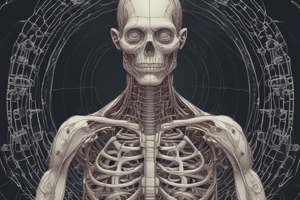Podcast
Questions and Answers
Which system is responsible for distributing oxygenated blood and nutrients throughout the body?
Which system is responsible for distributing oxygenated blood and nutrients throughout the body?
- Respiratory System
- Endocrine System
- Circulatory System (correct)
- Musculoskeletal System
Which component plays a vital role in respiration by contracting and relaxing during inhalation and exhalation cycles?
Which component plays a vital role in respiration by contracting and relaxing during inhalation and exhalation cycles?
- Brain
- Trachea
- Diaphragm (correct)
- Adrenal glands
Which part of the nervous system is responsible for transmitting sensory information to the brain?
Which part of the nervous system is responsible for transmitting sensory information to the brain?
- Spinal cord (correct)
- Peripheral nervous system
- Thyroid gland
- Large intestine
Which part of the body do flat bones primarily protect?
Which part of the body do flat bones primarily protect?
What is the main function of the heart in the human body?
What is the main function of the heart in the human body?
What is the main function of endocrine glands in the body?
What is the main function of endocrine glands in the body?
How many vertebrae are there in the spine?
How many vertebrae are there in the spine?
Which organ is responsible for the absorption of most nutrients in the digestive system?
Which organ is responsible for the absorption of most nutrients in the digestive system?
Which bones in the human body facilitate flexibility and stability?
Which bones in the human body facilitate flexibility and stability?
What is the primary role of the lungs in the respiratory system?
What is the primary role of the lungs in the respiratory system?
What structures provide attachment sites for muscles in the human body?
What structures provide attachment sites for muscles in the human body?
What is the main function of the musculoskeletal system?
What is the main function of the musculoskeletal system?
Flashcards are hidden until you start studying
Study Notes
Human Anatomy: Understanding the Complex Structure of Living Organisms
Anatomy is a crucial aspect of biology and medicine, studying the structure of organisms and their parts, while physiology explores the functions and processes behind these structures. Together, they provide an holistic understanding of living beings, helping us comprehend how various components interact to maintain homeostasis and promote survival.
Human Body Systems
Musculoskeletal System
This system consists of bones, muscles, ligaments, tendons, and cartilage that provide support, stability, movement, and protection for internal organs. Notable parts include:
- Skull houses the brain and facial structures.
- Spine supports the head and upper body, protecting essential nerves and blood vessels.
- Vertebrae are individual units of the spine; there are 33 vertebrae in total (including cervical, thoracic, lumbar, sacral, and coccyx regions).
- Long bones, such as femur and humerus, provide major structural support and serve as attachment sites for muscles.
- Short bones, like those in hands and feet, facilitate flexibility and stability.
- Flat bones, such as ribs, cranial bones, and sternum, protect vital organs and contribute to movement.
Circulatory System
This system distributes oxygenated blood and nutrients throughout the body and removes carbon dioxide and waste products via veins and arteries. Key organs and structures include:
- Heart pumps blood through vessels and maintains blood pressure.
- Blood carries gases, nutrients, hormones, waste products, and immune cells.
- Arteries and capillaries transport deoxygenated blood towards the heart, where it becomes oxygenated through gas exchange in the lungs.
- Veins collect oxygenated blood from tissues and return it to the heart.
Digestive System
The digestive system breaks down food into nutrients for absorption and eliminates waste products. Components include:
- Mouth initiates the process with chewing and saliva production.
- Esophagus transports food through peristaltic movements.
- Stomach secretes digestive enzymes and hydrochloric acid.
- Small intestine absorbs most nutrients and water, facilitating circulation of digested material.
- Large intestine extracts remaining water and electrolytes before excreting undigested material as feces.
Respiratory System
This system enables gas exchange between the body and the environment, primarily oxygen (O2) and carbon dioxide (CO2). Key components include:
- Nose filters and warms inhaled air.
- Trachea connects to the lungs via bronchioles, ensuring proper O2 uptake and CO2 removal.
- Lungs contain millions of tiny sacs called alveoli that facilitate gas exchange through diffusion.
- Diaphragm, a large skeletal muscle, plays a vital role in respiration by contracting and relaxing during inhalation and exhalation cycles.
Nervous System
The nervous system controls various bodily functions through communication between cells, including sensory perception and motor responses. Components include:
- Brain coordinates complex processes such as thinking, memory, emotions, and motor function.
- Spinal cord transmits sensory information from the peripheral nervous system (PNS) to the brain and vice versa via cranial nerves and spinal nerves.
- Peripheral nervous system contains sensory neurons that detect stimuli like touch, temperature, pain, or light, as well as motor neurons responsible for muscle contraction.
Endocrine System
Endocrines glands produce hormones which regulate various body functions such as metabolism, growth, development, and responses to stress. Key components include:
- Thyroid gland secretes thyroxine and triiodothyronine hormones that control basal metabolic rate.
- Adrenal glands release cortisol, adrenaline, and aldosterone to manage stress responses, blood sugar levels, and blood pressure.
- Pancreas produces insulin and glucagon to maintain blood sugar balance.
Conclusion
Understanding human anatomy provides valuable insights into our bodies' complex structure and the intricate interplay between different systems. This knowledge is essential for medical professionals seeking to diagnose and treat diseases effectively. By studying these systems in depth, we gain a deeper appreciation of biology and the marvelous mechanisms that sustain life.
Studying That Suits You
Use AI to generate personalized quizzes and flashcards to suit your learning preferences.



